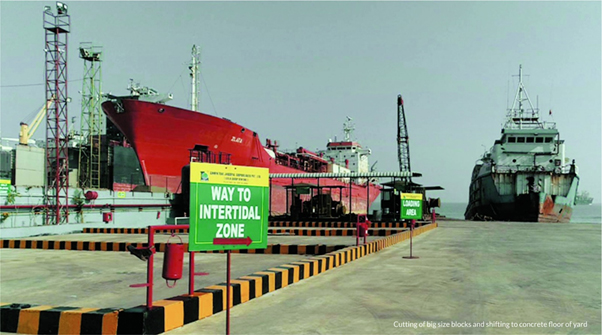How Shipbreaking Yard 'Alang' Reflects State Of The Global Economy
- 27th Jan 2021
- 1897
- 0

Popular shipbreaking yard in the Bhavnagar district of Gujarat, Alang has recently observed a que of luxury liners- with nearly four cruise ships that have visited to be broken in the past 50 days.
It is interesting to note how this site of ship wrecking has often been known as the mirror of our global economy. When businesses are up and flourishing, ships sail through the year resulting in low opportunities for Alang. On the other hand, when there is no business in the cruise tourism industry, more ships tend to be at Alang.
As a result of the pandemic, the cruise sector that usually attracts tourists from all across the world came to a standstill due to heightened safety concerns and lockdowns.
The unfortunate covid-19 outbreak on the Diamond Princess cruise vessel in Japan early on in February 2020 caused a ruckus amongst tourist and cruise travel enthusiasts. The outbreak resulted in over 3600 passengers and crew being quarantined at the Yokohoma Port. It eventually resulted in nearly 700 infections and 7 fatalities.
A vast number of cruise owners have been left in deep debts, losses and bankruptcy, while some are having to pay heavy interest, fuel costs and anchorage. Cruise-operations are to restart maybe 6 to 8 months from now, which has led to many cruise owners putting these luxury vessels up for sale or scrapping them entirely.

Usually, only one ship visited Alang on an annual basis. This year, the yard has already seen four ships, the first one being MV Karnika which reached in early November 2020. Due to being shut out since lockdown, the vessel had failed to restart.
40-year old Ocean Dream was the second ship at Alang which arrived on January 2nd after it lay still near Hiroshima for nearly a year.
Commissioned in 1965, luxury liner Marco Polo was next to reach Alang on January 9th. Being the fastest and largest luxury liner on the Soviet merchant fleet, this cruise was sold through a bankruptcy auction and had to be given off in scrap after the deal fell through.
A fourth luxury liner, Grand Celebrations that was built in 1987 is expected to reach Alang within this month itself.
Alang has always been a wise indicator of the global economy. In 2010-11 during a major global crisis nearly 415 ships were brought to the yard to be dismantled and sold as scrap.
Similarly, in 2018 during a rough patch in the global oil market, majority of the vessels reaching Alang were either an oil tanker or an oil rig.
Nearly 30% of the steel retrieved from scraps of these luxury liners are sent to re-rolling mills in Bhavnagar while the rest is spread across various regions of India like Punjab, Madhya Pradesh, Gujarat and Maharashtra.
With such a spike in the number of ships coming to Alang, there has been a renewed interest in the second hand market outside the yard.
 Neha Menon
Neha Menon


Comments
No comments yet.
Add Your Comment
Thank you, for commenting !!
Your comment is under moderation...
Keep reading luxury post